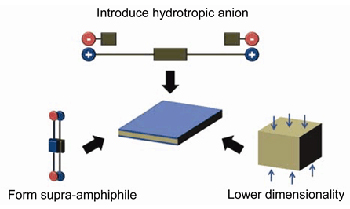| [1] Kimizuka, N.; Kawasaki, T.; Kunitake, T. J. Am. Chem. Soc. 1993, 115, 4387.
[2] Davis, R.; Berger, R.; Zentel, R. Adv. Mater. 2007, 19, 3878.
[3] Chen, Y.; Zhu, B.; Zhang, F.; Han, Y.; Bo, Z. Angew. Chem., Int. Ed. 2008, 47, 6015.
[4] Lee, E.; Kim, J. K.; Lee, M. Angew. Chem., Int. Ed. 2009, 48, 3657.
[5] Nam, K. T.; Shelby, S. A.; Choi, P. H.; Marciel, A. B.; Chen, R.; Tan, L.; Chu, T. K.; Mesch, R. A.; Lee, B. C.; Connolly, M. D.; Kisielowski, C.; Zuckermann, R. N. Nat. Mater. 2010, 9, 454.
[6] An, Q.; Chen, Q.; Zhu, W.; Li, Y.; Tao, C. A.; Yang, H.; Li, Z.; Wan, L.; Tian, H.; Li, G. Chem. Commun. 2010, 46, 725.
[7] Zhao, Y. S.; Fu, H.; Peng, A.; Ma, Y.; Xiao, D.; Yao, J. Adv. Mater. 2008, 20, 2859.
[8] Li, R.; Hu, W.; Liu, Y.; Zhu, D. Acc. Chem. Res. 2010, 43, 529.
[9] Li, S.; Huang, X.; Zhang, H. Acta Chim. Sinica 2015, 73, 913.(李绍周, 黄晓, 张华, 化学学报, 2015, 73, 913.)
[10] Israelachvili, J. N.; Marcelja, S.; Horn, R. G. Q. Rev. Biophys. 1980, 13, 121.
[11] Leontidis, E. Curr. Opin. Colloid. In. 2002, 7, 81.
[12] Song, B.; Wang, Z.; Chen, S.; Zhang, X.; Fu, Y.; Smet, M.; Dehaen, W. Angew. Chem., Int. Ed. 2005, 44, 4731.
[13] Yin, S.; Song, B.; Liu, G.; Wang, Z.; Zhang, X. Langmuir 2007, 23, 5936.
[14] Song, B.; Liu, G.; Xu, R.; Yin, S.; Wang, Z.; Zhang, X. Langmuir 2008, 24, 3734.
[15] Wu, G.; Verwilst, P.; Xu, J.; Xu, H.; Wang, R.; Smet, M.; Dehaen, W.; Faul, C. F. J.; Wang, Z.; Zhang, X. Langmuir 2012, 28, 5023.
[16] Wu, G.; Thomas, J.; Smet, M.; Wang, Z.; Zhang, X. Chem. Sci. 2014, 5, 3267.
[17] Wu, G.; Verwilst, P.; Liu, K.; Smet, M.; Faul, C. F. J.; Zhang, X. Chem. Sci. 2013, 4, 4486.
[18] Zhang, X.; Wang, C. Chem. Soc. Rev. 2011, 40, 94.
[19] Wang, C.; Wang, Z.; Zhang, X. Acc. Chem. Res. 2012, 45, 608.
[20] Zhang, X.; Wang, C.; Wang, Z. Sci. China-Chem. 2011, 41, 216.(张希, 王朝, 王治强, 中国科学: 化学, 2011, 41, 216.)
[21] Kimizuka, N.; Kawasaki, T.; Hirata, K.; Kunitake, T. J. Am. Chem. Soc. 1998, 120, 4094.
[22] Oda, R.; Huc, I.; Schmutz, M.; Candau, S. J.; MacKintosh, F. C. Nature 1999, 399, 566.
[23] Wang, C.; Yin, S.; Chen, S.; Xu, H.; Wang, Z.; Zhang, X. Angew. Chem., Int. Ed. 2008, 47, 9049.
[24] Zhang, X.; Chen, Z.; Wurthner, F. J. Am. Chem. Soc. 2007, 129, 4886.
[25] Liu, K.; Wang, C.; Li, Z.; Zhang, X. Angew. Chem., Int. Ed. 2011, 50, 4952.
[26] Li, F.; Song, Q.; Yang, L.; Wu, G.; Zhang, X. Chem. Commun. 2013, 49, 1808.
[27] Athikomrattanakul, U.; Promptmas, C.; Katterle, M.; Schilde, U. Acta Crystallogr., Sect. E: Struct. Rep. Online 2007, 63, o2154.
[28] Xu, J.; Wu, G.; Wang, Z.; Zhang, X. Chem. Sci. 2012, 3, 3227.
[29] Miyazaki, Y.; Kanbara, T.; Yamamoto, T. Tetrahedron Lett. 2002, 43, 7945.
[30] Yi, Y.; Fa, S.; Cao, W.; Zeng, L.; Wang, M.; Xu, H.; Zhang, X. Chem. Commun. 2012, 48, 7495. |
